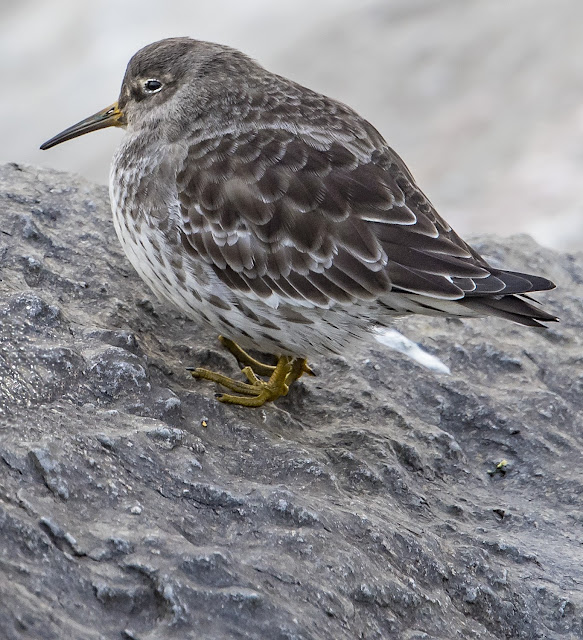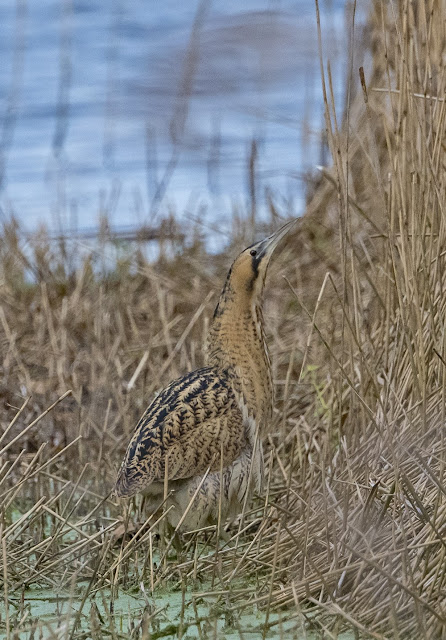Sunday, 31 December 2017
Friday, 15 December 2017
A Rather Blustery Day in North Wales
I had another trip to the seaside today with Purple Sandpipers as my main target species. These hardy little winter visitors from the Arctic visit Rhos Point at Rhos-on-Sea each year and the best time to see them is at high tide when they are roosting on the breakwater rocks along the shoreline.
I'd managed to get some shots of Purple Sandpipers last month at New Brighton, but they were roosting on the marina pontoons and this is hardly a natural setting, so I was looking for better natural habitat for my photos today.
As can be seen and heard in the video, it was blowing a gale whilst I was there and this made taking photographs and video very difficult - despite using a heavy tripod and gimbal system, I couldn't really keep the camera steady.
At first I struggled to find these birds, and when I thought I had spotted one it turned out to be a dark Dunlin. But with a bit of perseverance walking up and down the promenade, I eventually spotted one bird feeding on the rocks and then later a group of four roosting.
Later I went on to RSPB Conwy a little further up the coast as I'd heard that a male Hen Harrier had been seen in recent days. I did get a very brief glimpse of it and took the worst record shot in the world!
I'd managed to get some shots of Purple Sandpipers last month at New Brighton, but they were roosting on the marina pontoons and this is hardly a natural setting, so I was looking for better natural habitat for my photos today.
As can be seen and heard in the video, it was blowing a gale whilst I was there and this made taking photographs and video very difficult - despite using a heavy tripod and gimbal system, I couldn't really keep the camera steady.
At first I struggled to find these birds, and when I thought I had spotted one it turned out to be a dark Dunlin. But with a bit of perseverance walking up and down the promenade, I eventually spotted one bird feeding on the rocks and then later a group of four roosting.
Other birds present included Turnstones and Ringed Plovers as well as the ubiquitous Oystercatchers. I did think I might have seen some Twite feeding on the beach, but they turned out to be Linnets.
Unfortunately this is not a Twite as I first thought, it's a Linnet.
Later I went on to RSPB Conwy a little further up the coast as I'd heard that a male Hen Harrier had been seen in recent days. I did get a very brief glimpse of it and took the worst record shot in the world!
There was also a pair of Red-breasted Mergansers in front of one of the hides - here's some shots of the male.
And this female Scaup was also present in the deeper water, along with some Pochards.
And finally, this little Robin came incredibly close, but then Robins do, don't they?
Sunday, 10 December 2017
End of Year Review 2017
For many people it's traditional to do an end of year review about whatever projects they undertake in their work or private lives. I've never really felt the need to do this before, but 2017 was such a special birding and wildlife year for me photographically that this time, I will.
January
January
- Dusky Thrush
- Crossbills
- Bought 500mm lens
- Norfolk Trip - Bluethroat, Crane, Egyptian Goose etc
- Bittern
- Slimbridge and Forest of Dean - Blue Rock Thrush, Hawfinch, Bewick etc
- Mull Trip - WTSE, GE, Otter etc
- Black-necked Grebes
- Broken Lens
- Grasshopper Warbler
- Bee-eater
- Nightjar
- Farne Islands Trip
- Caspian Tern
- Purple Heron
- Barn Owl at Cresswell
- Red-breasted Flycatcher
- Red-backed Shrike
- Long-billed Dowitcher
- Donna Nook Trip
- Goldcrest
- Chough
- Hawfinch
- Grey Male Hen Harrier
- Marsh Harrier
- Bittern
- Dusky Thrush (Beeley, Derbyshire, January)
- Eastern Black Redstart (Skinningrove, North Yorkshire, February) - Subspecies or race
- 'Black Brant' Brent Goose (Kilnseas, Spurn, February) - Subspecies or race
- Pallid Harrier (Welwick Marsh, near Spurn, February)
- Bluethroat (Willow Tree Fen, Lincolnshire, February)
- Glaucous Gull (Winterton-on-Sea, February)
- Crane (Hicking Broad, February)
- Egyptian Goose (Hickling Broad, February)
- Pine Bunting (Dunnington, near York, March)
- Goshawk (Wykeham Raptor Viewpoint, March)
- Blue Rock Thrush (Stow-on-the-Wold, March) - possible escape
- Eurasian White-fronted Goose (Slimbridge WWT, March)
- White-tailed Eagle (Mull, March)
- Black-crowned Night Heron (Shrewsbury, May)
- Grasshopper Warbler (Bickershaw, May)
- Bee-eater (East Leake, Notts, May)
- Nightjar, (Budby, Notts, May)
- Caspian Tern (RSPB St. Aidan's, July)
- Purple Heron (RSPB Leighton Moss, August)
- Leach's Petrel (New Brighton,Wirral, September) - distant
- Manx Shearwater (Leasowe, Wirral, September) - distant
- Red-breasted Flycatcher (Kilnsea, Spurn, October)
- Red-backed Shrike (Easington, Spurn, October) - brief
- Long-billed Dowitcher (Banks Marsh, October) - distant
Saturday, 9 December 2017
Far Ings - My New Favourite Place
Following a recommendation by Paul Coombes, who I met on Facebook earlier in the year and then who kindly took me to see the Nightjars in Sherwood Forest in July this year, I've been planning to visit the Far Ings and Alkborough Flats Nature Reserves in Lincolnshire for some time now.
I was originally hoping to call in at Far Ings on may way back from Donna Nook last month, but the short days got the better of me and I decided not to go as the light would have dropped by the time I arrived. So with the prospect of good sunny weather today , I left at 7am this morning to see what I could find. The target birds were Marsh Harrier, Bittern, Kingfisher and Bearded Tit.
This bird caught and killed a Moorhen and then managed to drop it into the reeds. It then spent quite long time trying to refund it.
The Harrier shots are generally not as sharp as I would like because as soon as the birds came out, the sun went in, obscured by clouds. But they are the best shots I've got of this species so far, so that's why Far Ings is my new favourite place. And you can rest assured that I'll be back.
And the one bird that you'd think you could bank on seeing and getting a decent photograph stayed distant all the time I was there. This Kingfisher has to be one of the most photographed birds here, but today all I got was this shot. And neither sight nor sound of any Bearded Tits anywhere.
On arriving at Ness Hide at Far Ings, my attention was immediately drawn to a distant Bittern on the edge of the far reed bed, and there were two present according to the locals in the hide. However it was some time before one reappeared flying quite high over the water and then eventually settling in reeds in front of the hide, which is where I got the above shots.
I was soon joined by Kevin Robinson, another photographer who I'd chatted to on Facebook regarding the best places to see Marsh Harriers here - I didn't know who it was until I asked him directly and then we both realised that we'd been in contact and exchanged information. And it wasn't long before this female Marsh Harrier appeared in front of us. This was the closest I've ever come to Marsh Harriers and I was quivering with excitement as I pressed the shutter.
This bird caught and killed a Moorhen and then managed to drop it into the reeds. It then spent quite long time trying to refund it.
It's not often that a Bittern gets upstaged, but for me the best bird of the day was this male Marsh Harrier which made just one pass across the far reed beds before disappearing.
The Harrier shots are generally not as sharp as I would like because as soon as the birds came out, the sun went in, obscured by clouds. But they are the best shots I've got of this species so far, so that's why Far Ings is my new favourite place. And you can rest assured that I'll be back.
And the one bird that you'd think you could bank on seeing and getting a decent photograph stayed distant all the time I was there. This Kingfisher has to be one of the most photographed birds here, but today all I got was this shot. And neither sight nor sound of any Bearded Tits anywhere.
Labels:
Bittern,
Marsh Harrier
Thursday, 7 December 2017
A Precious Moment on the Dee Marshes
I had one of those birding moments today whilst out on the Dee Marshes today. I went to the Wirral for the last of the recent 9 metre high tides, starting off at the Parkgate and ending up at Denhall Quay in Little Neston.
There was nothing much showing at Parkgate apart from this distant solitary Marsh Harrier and so I didn't stay there too long, deciding to head off to Denhall Quay via a Tesco Express in Neston for a £3 Meal Deal - the cold weather made me starving by lunchtime!
There was a bitingly cold wind on the coast and I thought this might have enhanced the high tide as it was blowing inland. However, the tides didn't seem any higher than normal and it didn't really bring any more birds out than usual. It was too windy for the Short-eared Owls here today, they don't seem to fly in the wind if they don't need to. So Harriers were my best hope - and boy did one come.
This grey male Hen Harrier breezed past whilst I was stood about 100m out on the marsh looking back inland. I was so excited that I fumbled with my camera in the freezing wind and the shots haven't come out as sharp as I would like. It was very difficult just standing still, nevermind keeping the tripod still and all this vibration hasn't helped the photographs. But at least I got my best shots to date of this fabulous rare bird.
Whilst awaiting the arrival of some Harriers I spotted this distant squabble between a Buzzard and a Raven - it's usually the other way round with the Raven mobbing the Buzzard, but today the tables were turned. It's nice to see the size difference between th two birds in this shot. Buzzard are big so Ravens must be huge!
So what I've learnt from birding over the last few years is that the more I go out, the luckier I get, if you understand what I mean. In other words, you've got to be in it to win it.
Labels:
Buzzard,
Curlew,
Grey Male Hen Harrier,
Kestrel,
Little Egret,
Marsh Harrier,
Raven,
Stonechat
Subscribe to:
Comments (Atom)






















































